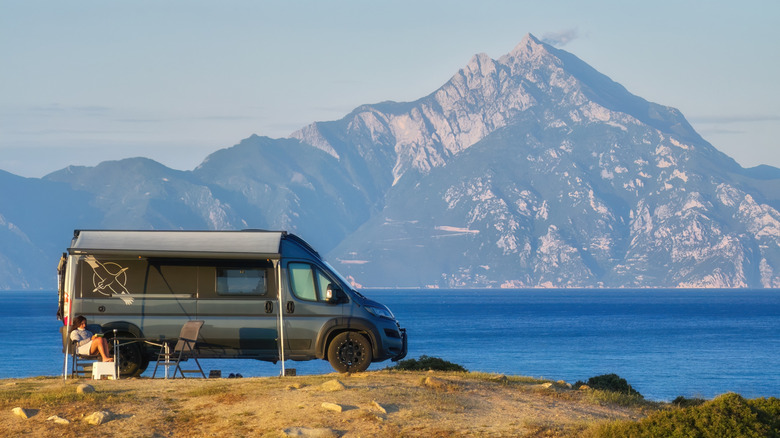
With a campervan -- which is different from a travel van -- you can spend multiple weeks off the beaten path, without worrying about shelter, hygiene, or rationing supplies. Instead of trudging to communal facilities or rationing water from plastic jugs, you simply walk 10 feet to your own kitchen, bathroom, and shower. That's the magic of camper van life -- the freedom to explore wherever your wanderlust takes you, but without stress and worry. Now, if money were no object, buyers would probably
be eyeing luxury camping RVs from brands like EarthRoamer, the Rolls-Royce of expedition vehicles. EarthRoamers are cool, but with price tags starting around $798,000, they're about as accessible as private jets.
Fortunately, you don't need to spend house money to embrace van life. While brand-new camper vans typically start around $150,000 on the cheaper end, the used market is much more reasonable, and even brands like Honda might be jumping on the bandwagon. With some careful shopping and perhaps minor renovations, older models can provide the same freedom and comfort at a fraction of the cost. That said, we'll also include some 2025 models for the discerning buyer. Here are six new (and six used) campervan models that won't break the bank.
Read more: 10 Luxury Cars That Are Cheap To Maintain
Converted RAM Promaster 2500/ 3500 – $40,000
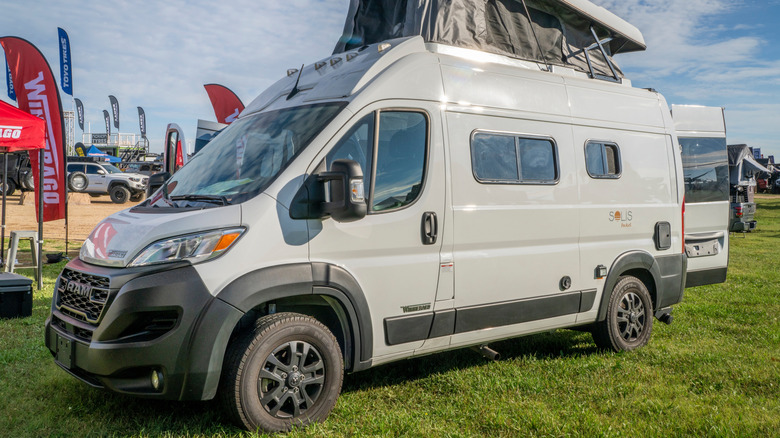
We begin with a brand that many will be familiar with: Dodge. Specifically, its RAM series of vans, known as the Promaster, was a popular choice for conversion to campervans. They were solidly built, spacious in the back, had actual drivability around the city, and came with a choice variety of engines. In fact, converting a regular cargo van to a camper van is still very much a thing, and can even be done as a DIY project if you have the time. At the time of writing, several used examples of converted Dodge Promaster camper vans are available on the used market, ranging from $25,000 for old models, going all the way up to and beyond the $80,000 mark.
Sweet spot units can be had around the $40,000 mark, coming with all the bells and whistles one would want in a vehicle of this type. For instance, features to keep an eye out for include a fold-out bed (more space when not in use), a kitchen of sorts, a compost toilet (easier cleaning), a shower, and a closet, which many vans around the $40,000 mark have. In terms of model years, try to get something relatively recent, like models made after 2015, as these are more likely to be in better condition. In addition, while having a larger van like the massive Promaster 3500 would indeed be nice for longer trips, if you won't get that much use out of it, the 2500 would be more manoeuvrable and fuel efficient.
2015+ Thor Motorcoach – $50,000
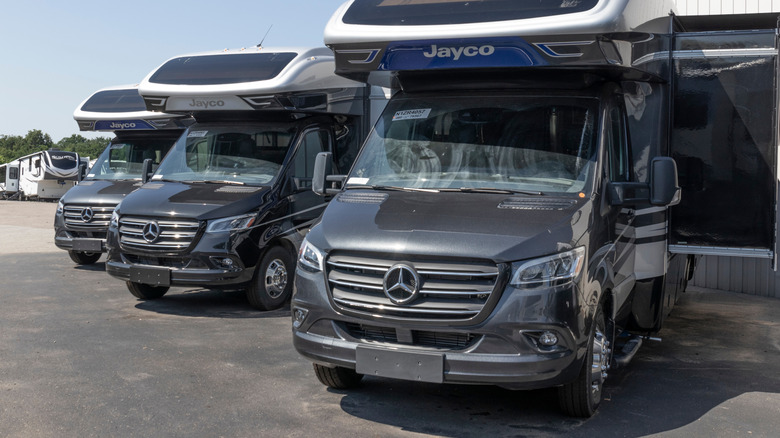
Thor was founded in 1980 after acquiring Airstream, specifically for the purpose of making and converting cargo and transit vans into camper vehicles through subsidiaries like Jayco. After initial struggles, over the years, quality, fit, and finish increased along with price. While a new Thor Sequence would cost about $150,000 in 2025 -- and that's the price before customization and options -- there are much better deals to be had on the used market. Take, for starters, the motorcoach, which was available in many editions, which is Thor-speak for trims, including Four Winds, Compass, Tranquility, and Rize, among dozens more. Any edition would be a good deal, as Thor floorplans remain unbeaten. Just make sure that you're buying the right class of vehicle.
At the time of writing, a decent used Thor motorcoach can be had for between $50,000 and $60,000. These come with all the standard utilities such as a kitchen area, shower, bathroom sink, and lavatory. However, most units will have a great many creature comforts as well, such as slide-outs to increase area, awnings for shade, rear air conditioners, and sleeping space for five passengers. The base engine depends on the donor car, but for the larger Ford-based models, it is a 6.8-liter V10 unit that makes 305 hp and 420 lb-ft of torque, which is plenty for this size.
2000+ Ford Econoline Campervan – $20,000
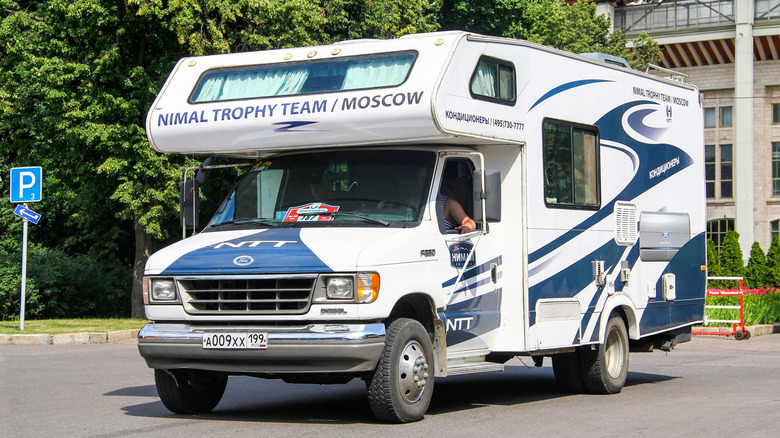
America's favorite blue oval company built a cargo van called the Econoline up until 2014, which is when it was replaced by the Ford Transit, which we'll also cover. When they were being produced, the Econoline vans were actually America's best-selling large van, and were also the second-longest-running Ford model. Despite questionable aesthetic choices, Ford E-series vans that have been converted into campers are the most affordable entry point, at least into camper vans that can move under their own power. Currently, Ford Econoline campers are selling for about $20,000 for fantastic builds, though some can be had even cheaper. Units made around 2000 came with a 4.6-liter V8 that made 225 hp and 286 lb-ft of torque.
Bigger versions, such as the ones built on the E350 platform, come with more space, a bigger 255 hp 5.4L V8 as standard. However, we don't want to sell you the wrong dream. Parts and experienced labor will be increasingly hard to find for such old vehicles. It's a fantastic camper van for those looking to enter the genre, and who don't want to buy a $150,000 vehicle that will turn into a very large decoration if they don't fancy the activity anymore.
2013+ Mercedes Sprinter Camper – $40,000
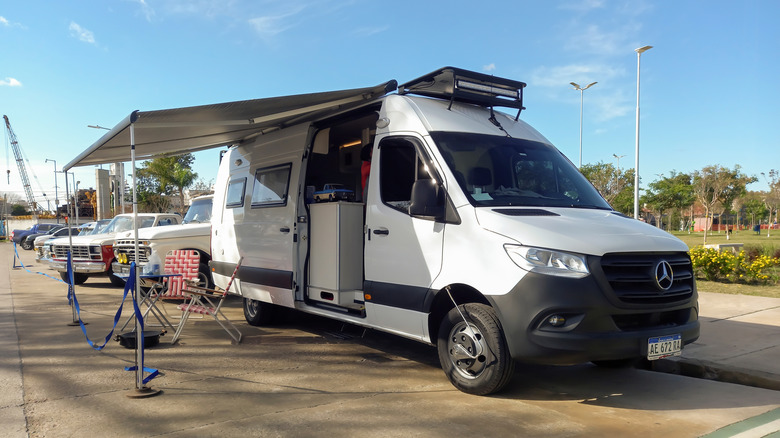
There are many reasons the Mercedes-Benz Sprinter makes for a fantastic campervan -- the first of which is the size. It is 5,910 mm (233 inches) long, 1,787 mm (70.4 inches) wide, and most importantly, has a minimum internal height of 1,789 mm, or 70 inches. A 2025 Sprinter comes in with a base MSRP of $53,125 -- and that's just for the van, without any of the associated conversion costs. Compare that to the $40,000 or so that a fully-built, used Sprinter camper can be had for on the secondary market, and the bargain is obvious.
When shopping around, search for units that have a lavatory, shower (even an external one is fine), kitchenette, and storage, as these are the bare necessities to justify investing in a camper van in the first place. Additionally, finding Sprinters made after 2013 is an added bonus, as that year the van received a facelift, giving it a much better overall aesthetic. Features added to the 2013 Sprinter included plusher seats, a better audio system, collision avoidance, and blind spot warning. Plus, the prices of 2012 and earlier Sprinters aren't that different from the 2013-2018 models, so it's a justifiable upgrade. The base engine on the 2013 Sprinter was a 3.0-liter V6 unit that made 188 hp and 325 lb-ft of torque, paired with a five-speed transmission.
2015+ Palomino Puma (Any Series) – $15,000
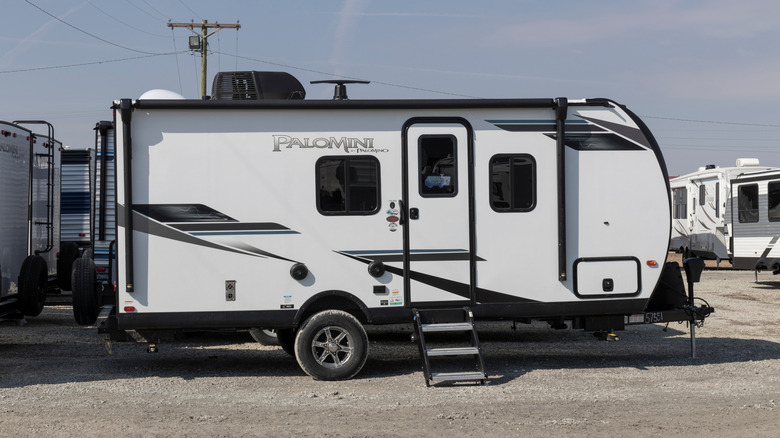
While not strictly a van, getting a Palomino caravan is one of the most affordable entry points to the world of car-camping. Models like the Puma start from about $15,000 for entry-level used examples, and versions with all the bells and whistles can be had for about $25,000 and up. Many come standard with air conditioning, generators, sleeping capacity for multiple people, and leveling jacks. Palominos make for great first camper vehicles. Their size means that there's a lot more usable space inside the camper than smaller vans like the Econoline that we covered above.
Additionally, since these units don't have to propel themselves, all the space inside is available to use. Furthermore, with the large windows and commonly found (but not standard) roof vents, Palomino caravans let in a good amount of natural light, which adds to the roomy feeling. The downside, of course, is that buyers need to have a whole other vehicle to get anywhere. Also, that second vehicle needs to be properly outfitted and rated to pull the hulk and bulk of these magnificent campers -- some of which weigh around 9,000 pounds.
2015+ Ford Transit – $40,000
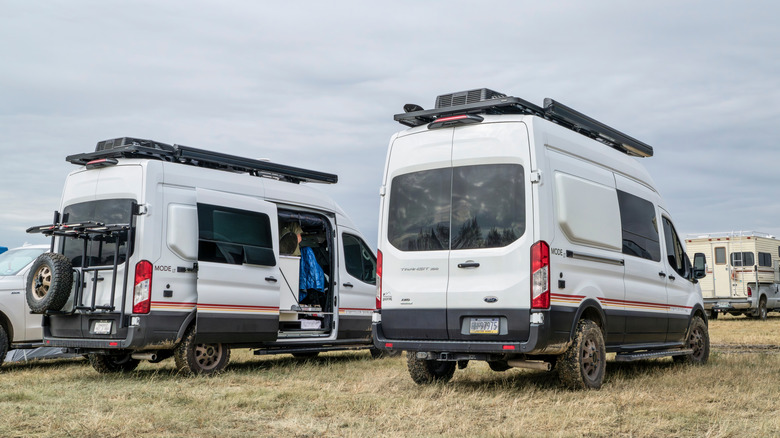
The last of the used camper vans on our list is another conversion variant. Just as the Promaster is a common donor vehicle for turning into camper vehicles, so too is the Ford Transit. Look for models made after 2015 to have a decent shot at not buying a rust-bucket. The turnkey (ready to use) Ford Transit camper conversions from 2015 or later also cost about the same, coming in at $40,000 or so for models with good facilities in decent condition. Additionally, much aftermarket and community support is present for the Transit in the camper van community, with new mods and equipment being released every month.
In terms of engine choices, the base-model Transits after 2015 usually came with a V6 that displaced 3.7 liters and produced 275 hp with 260 lb-ft of torque. The drive mode was RWD by default, and it gets around 13 mpg on the lower end. Features to look for, as always, on these smaller units include generators or solar power systems, well-ventilated cabins, a head (lavatory), shower, and kitchenette. Lastly, we advise potential buyers to search for medium-roof or high-roof models of the Transit, which add about 20 and 28 inches of headroom in the back, respectively -- it makes an enormous difference in perceived (and actual) spaciousness.
Winnebago Plus Adventure Wagon – $153,459
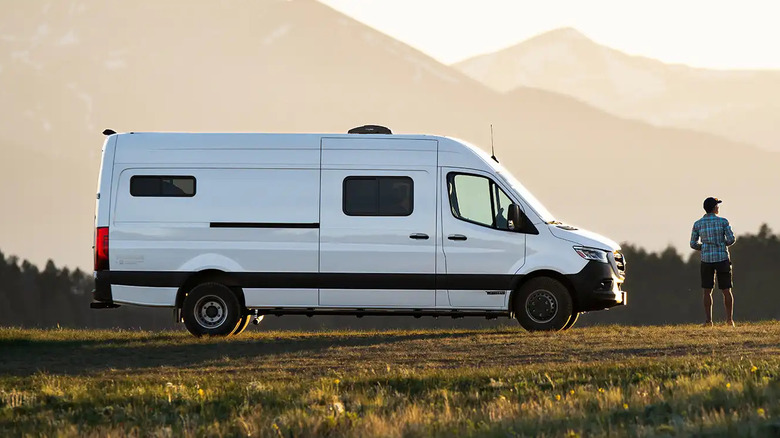
Let's move on to six new campervan models for buyers who want nothing but the best without spending half a million dollars. These units aren't exactly cheap -- most of them cost around $150,000, but are actually a reasonable deal for what they deliver. We start with the 2025 Winnebago Plus Adventure, which has a base MSRP of $153,459 at the time of writing. So, what do buyers get for two-and-a-half times the national median wage? Well, for starters, a MOAB bed with an included mattress, multiple shelves rated for 100 pounds, which sit on adjustable tracks, and a 3.6 kWh generator. Since it is based on a Sprinter, the engine is a 3.0-liter V6 unit that churns out 188 hp and 325 lb-ft of torque, mated to a seven-speed automatic transmission.
In the base configuration, the Winnebago Plus adventure can house up to four people, though anything more than two would end up being a bit of a squeeze in our opinion. Remember that when buying new, buyers can choose to specify whatever features they might need, as these campervans are quite bespoke. These newer Winnebagos tend to hold their value quite well. Eight-year-old units from 2017, which cost $136,272 new, are changing hands today for about $96,000.
2025 Coachmen Beyond – $139,995
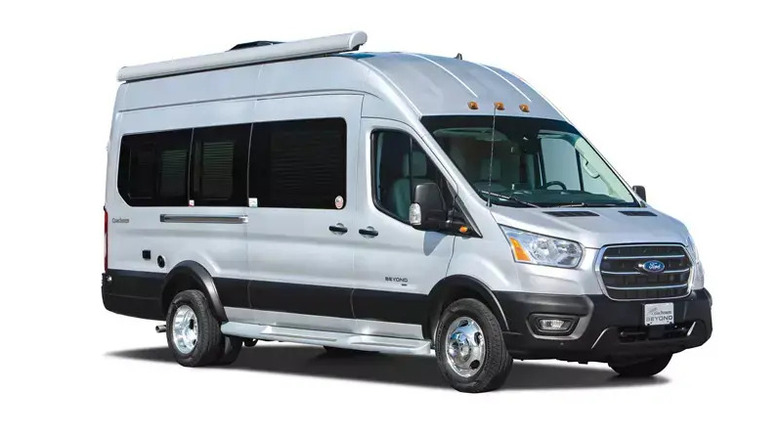
Next up, we have the Coachmen Beyond, which is a fully self-sufficient camper van that retails for a base MSRP of $139,995 when new. This price is for the 2025 model and does not include destination fees, which Coachmen does not publish. Notable features on the 2025 Beyond include keyless entry, remote starting, a 2.8 kW generator, a 2,000-watt inverter, and a 195W Solar panel. There are three floor plans available, with twin beds, twin sofas, or a single large power sofa at the back of the van. The standard engine on the entry-level variant is a V6 that displaces 3.5 liters and turns out 310 hp and 400 lb-ft of torque. This, paired with a ten-speed shiftable auto transmission and rear-wheel-drive by default, means that it'll be a comfortable ride.
Dimension-wise, the Beyond 22C is 2,134 mm (84 inches) wide, 6,756mm (266 inches) long, and 2,743 mm (108 inches) tall. These dimensions are pretty bulky, meaning that it may be a pain to navigate through the city on the way to your destination, but being cocooned in the upholstered luxury interior will be well worth it. Grey water can be an issue, as the tank on the 2025 Beyond can only hold about 15 gallons. Other than these two small gripes, there's nothing wrong with the Beyond, and nice specimens maintained properly ought to serve buyers for many years to come.
2026 Thor Sequence – $151,900
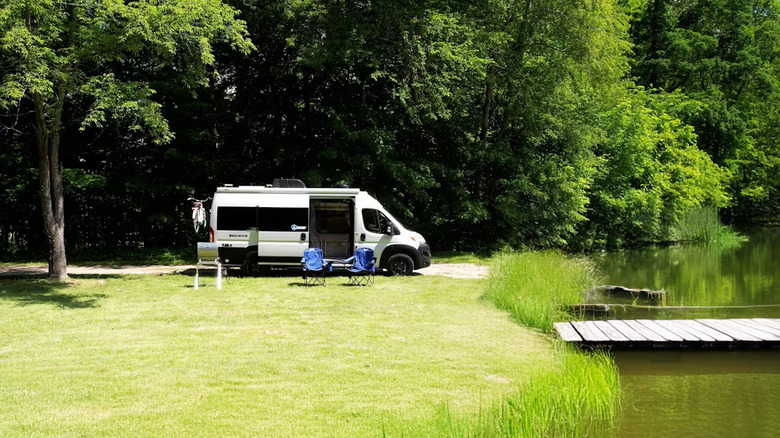
We briefly alluded to Thor at the beginning of this article when we talked about the motorcoaches that Thor makes, and how much of a great deal they were. Well, if buyers want to customize one of those fantastic motorcoaches for their specific tastes and needs, they can look to the 2026 Thor Sequence. It is built on the base of a RAM Promaster 3500 heavy-duty van, and heavily customized to the point that the interior is unrecognizable. The base MSRP is $151,900, with a massive catalog of customization options -- everything can be tailored to the buyer's fancy.
Be advised that, unlike Winnebago models, Thor's offerings tend to depreciate a lot more -- with some 2022 units selling for around $79,999 at the time of writing, whereas they would have run buyers $120,985 in 2022, equivalent to $132,894 today. Talking points on the 2026 Sequence include the 5,000-pound hitch, external LP connection for cooking, 24-inch smart TV, standard 200-watt solar charger, and the choice of a rear pull-out sofa or twin beds. The default engine is a 3.6-liter V6 Pentastar engine that produces 276 hp and 250 lb-ft of torque, and has a nine-speed automatic transmission. The 2026 Sequence will be able to sleep a maximum of two passengers, and is currently open for orders.
2025 Roadtrek Zion – $172,100
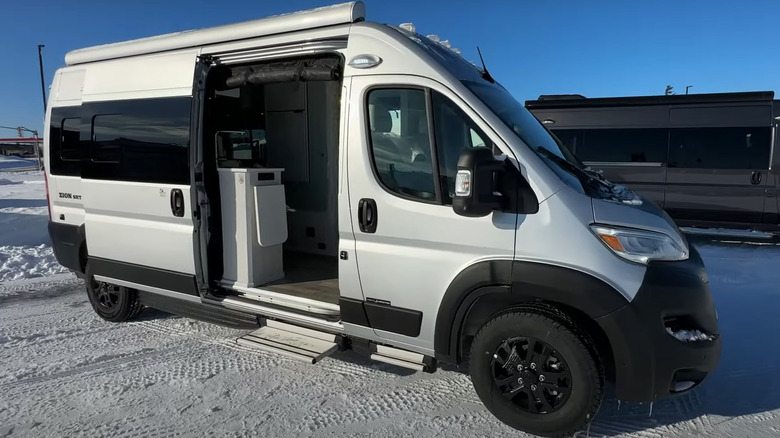
The next new campervan on our list is the 2025 Roadtrek Zion, which was named after the name of God's home in the Christian Bible. Starting at $172,100, it is far from affordable, but it can potentially make sense for the right kind of buyer, who values comfort over cost. The 2025 Zion comes with a wet bath, a fully-functional fridge, a 13,500 BTU roof-mounted air conditioner, smart interior controlled via a touchscreen tablet, and a 300-watt solar charger. Like many of the other models on this list, the Zion is built using the RAM Promaster 3500 as a donor car -- specifically the 159-inch version.
The entry-level engine is a 3.6-liter V6 powerplant that makes a total of 276 hp and 250 lb-ft of torque. This powerplant drives the wheels via a nine-speed automatic transmission and has a fuel economy of 17 mpg on the 2023 model, so the 2025 model should be fairly similar. With space for up to four passengers, it's perfect for couples and two-child families, and offers several unique creature comforts that the other campers on this list might not. Examples of that include inbuilt awnings, a furnace, an underhood generator, an outdoor shower, and a standard power-rear sofa.
2026 Pleasure Way Lexor TS – $175,500
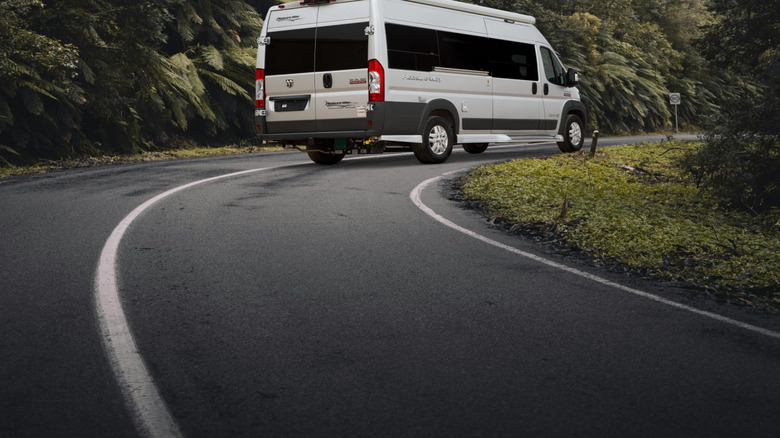
The most expensive camper van on our list is the $175,500 2026 Lexor TS, made by a company called Pleasure Way, which operates out of Saskatoon, Canada. Noteworthy features on the Lexor TS include roll-up door linings, a standard solar charging system, a power awning, an outer shower (handheld), an external LP gas connection, and a swing-out 24-inch smart TV. The base engine is, again, a Pentastar 3.6-liter V6 unit that produces 276 hp and 250 lb-ft of torque.
The Pentastar is paired to a nine-speed transmission that sends all the engine's output directly to the front wheels. We should also mention the dimensions of this thing, as it is massive, coming in at 2,830 mm (111 inches) tall, 2,500 mm (98 inches) wide, and 6,370 mm (251 inches) in length. Fuel consumption may also be an issue, given the maximum allowable weight or gross vehicle weight rating (GVWR) of the vehicle, which comes in at around 9,350 pounds.
2025 Winnebago Solis – $156,254
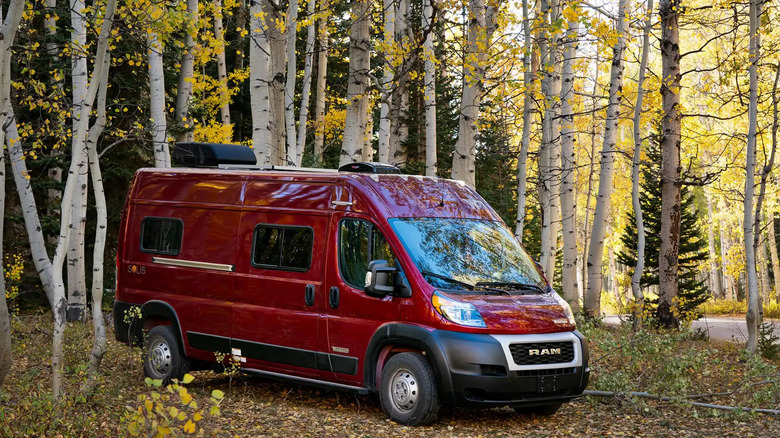
The last new campervan on our list also comes from Winnebago, this time in the form of the 2025 Winnebago Solis. Though the entry-level Solis starts from $156,254 and has long been a favorite in the community, there are two other editions available. There's the Solis Pocket, which, as the name suggests, is a smaller version of the Solis, coming in with a base MSRP of $143,475, and the Solis NPF, with its $163,105 price tag -- all prices before options. NPF is an acronym for National Park Foundation, and is a limited edition version of the Solis that adds some co-branded internals to the car, along with some aesthetic bits and bobs.
The default engine is the same Pentasar V6 unit that you're already familiar with by now, which produces 280 hp and 250 lb-ft of torque while displacing 3.6 liters. This powerplant is mated to a nine-speed automatic transmission with overdrive. The Solis has a gross vehicle weight rating of 9,350 pounds -- the same as the Pleasure Way Lexor TS from above, and a towing capacity of 3,500 pounds. In addition, it has a 20-gallon fresh water tank, as well as a 20-gallon grey water tank, and no black water tanks. That is why, even though the Solis has a larger grey water tank than most other campervans on this list, users will still have to ration their non-drinking water on longer trips.
Want the latest in tech and auto trends? Subscribe to our free newsletter for the latest headlines, expert guides, and how-to tips, one email at a time.
Read the original article on SlashGear.













